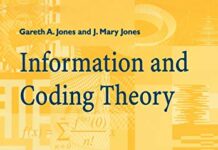
Ebook Info
- Published: 2012
- Number of pages: 306 pages
- Format: PDF
- File Size: 101.43 MB
- Authors: Gareth A. Jones
Description
An undergraduate-level introduction to number theory, with the emphasis on fully explained proofs and examples. Exercises, together with their solutions are integrated into the text, and the first few chapters assume only basic school algebra. Elementary ideas about groups and rings are then used to study groups of units, quadratic residues and arithmetic functions with applications to enumeration and cryptography. The final part, suitable for third-year students, uses ideas from algebra, analysis, calculus and geometry to study Dirichlet series and sums of squares. In particular, the last chapter gives a concise account of Fermat’s Last Theorem, from its origin in the ancient Babylonian and Greek study of Pythagorean triples to its recent proof by Andrew Wiles.
User’s Reviews
Reviews from Amazon users which were colected at the time this book was published on the website:
⭐That the book’s almost square is easily gathered from the photo. That it’s almost perfect must be verified by reading it. And what an enjoyable verification indeed awaits those who take on the challenge! Not that reading it is a challenge – on the contrary, the Joneses take every effort to ensure your learning experience be as painless as possible. Every proof is complete, all exercises are solved. The proofs are always selected for their instructional merit, rather than for their mathematical “elegance” (read: brevity and algebraic gimmickry). As one Amazonian reviewer put it: you could read it through, lying in a bubble bath.Another Amazonian reviewer commented that “Number theory is like the cement on your driveway. Real and Complex analysis are the Porsche and Ferrari you drive home every night.” I disagree. In any case, in my opinion the book’s weak spots are those sections where the discussion forays into the realm of real and complex analysis, namely 9.4-6 (“Random Integers”, “Evaluating Zeta(2)”, “Evaluating Zeta(2k)”), 9.9 (“Complex variables”), 10.2 (“The Gaussian Integers”), a part of 10.6 (“Minkowsky’s Theorem”) and 11.9 (“Lame and Kummer”). “Sums of two squares” (Section 10.1) could also use improvement, but this is compensated by the excellent, independent treatment this topic receives in the “Minkowsky’s Theorem” chapter.On several occasions, from the very beginning, the book assumes familiarity with single-variable polynomials (particularly the division algorithm and the x^n-y^n expansion). Be prepared.If it weren’t for the forays mentioned above, the book would have been a straight fiver. But even as it stands, it’s a tour-de-force of pedagogy and expository mathematical writing.One last quibble. The book doesn’t have a homepage, nor is there any indication of a way to contact the authors. Textbook publishers should learn from their colleagues in the applied computer science publishing industry (such as O’Reilly, Wrox, Apress, etc.) and always make a homepage available for every book, with, at the minimum, a link to an errata page, and a forum where readers of the book can discuss it, (preferably with the involvement of the author(s)).
⭐I originally bought this book to gain the knowledge and have an advantage in competing in Math Olympiads, but this book deters from that purpose.The book skips many important subjects, (such as qualities of divisors, essential qualities of prime numbers). Also, it is not that straightforward. Although I have learned a few tricks from this book, the book skips many steps in proving theorems, which, although may be filled by a teacher or student, the skipped steps are beyond the level of an average person reading this book.Also, it is not very clear in its approaches, since it assumes the reader has learned many mathematical notations (such as cyclotomic polynomials, derivatives from Calculus, etc, etc), which can be confusing for the average high schooler.Also, the exercises in this book are not very consistent with the topics of the book, such as proving theorems beyond the scope of the already learned knowledge, as well as the lack of problems actually consistent with the topics of the book (such as find the gcd(21390, 123, or 1290x+9233y=1, find solutions to x and y, if any). This book only gives me 1 or 2 of those problems, and then moves on. Many times I have found myself to have the need to re-read the materials from the book because of its lack of review sections. I have even seen online notes from people about number theory more consistently put together than this book, which also have firmly emplaced their knowledge into my mind.Another realization I have is that this book does not fit the skill level of a high schooler, or even an undergraduate. Many times the exercises and the proofs in the book give either very easy problems, or very hard problems. Such problems include (find gcd(234, 123), then skipping to proving if 2^m+1 is prime, then m is prime as well, as well as proving Eintstein’s criterion for polynomials).They do not provide many “in between” problems, and so, part of the learning becomes defunct, or people might even be discouraged by the book.However, I do realize that this book may be useful for undergraduates taking cryptography, this is however, not useful for anyone who is studying for math competitions.
⭐The writing is clear. It is a unique way of looking at math history. Traditionally taught straight timeline and the student is left to tie the subject history together. Good addition to a straight timeline.
⭐The pacing in this book is phenomenal. Every topic is explained with more than enough detail and without tangents.The one thing this book does better than any other Number Theory book are the in-chapter questions. The questions are done so well that WANT to do them. You feel as if you are missing vital information by not doing them. This is one of the few books I can study for hours on end because you are constantly being engaged as you are working through the chapter, instead of mindlessly reading and hoping you remember everything you’ve just read. They questions aren’t very difficult (full worked solutions for every problem if needed), but they are just hard enough to make you have to think.That is also it’s only downside. You cannot jump between sections sometimes. The book assumes you follow it from the beginning of a section to the end as it sometimes teaches you vital information via the in-chapter questions.If you are looking to self-study then you will not find a better book. I’ve tried every Number Theory book with decent ratings on Amazon, and this is by far the best.
⭐Good content and well laid-out. The format of formally defining a theorem or lemma then providing proof and worked examples is a good way to learn and revise the subject matter. The writing style is rather concise, which makes the book rather compact for the volume of content but also means that the subject matter isn’t as easy to grasp as something with a more casual approach, but still manageable.My main gripe is the typesetting, which, for a mathematics textbook, is rather important. I was a but stumped in the first chapter where Euclid’s Algorithm and Bezout’s Identity is covered when I had to re-read an example (1.3 and 1.4) multiple times because a multiplication was written using the point (.) character instead of the dot(·) character, i.e. “1492 = 1.1066 + 426” (which is clearly wrong).Ignore the people telling you the content is difficult to find. I used the “Table of Contents” and “Index” features, both of which are rather useful for finding you way around textbooks.
⭐Which level is the book aimed?This book (i.m.h.o) is a carefully composed introduction to underpinning knowledge of Number Theory topics. Its true -as its stated in the book- that introductory parts may be ‘A’-level, but this builds beyond this without becoming worrying or intimidating! After a several weeks of effort on my part, I have found this book both helpful and clarifying and worth the time studying it. I found this book layout enjoyable, progressive and interesting. Also its questions and answers (in the back) kept me going. Later on,after several chapters, if you have algebra insight from other sources than this book, you may sail through these areas with some ease.Final thoughtsPersonally, I found this book as a whole as stimulating as a maths book could be. Overall I really enjoyed this book, and I have seen the ‘Springer’ library is sometimes recommended in academic study book lists. It contains a simple proof of the Pythagorean theorem which is beautiful.
⭐Explanations are lucid and insightful and the exercises are well-chosen. The book is very well suited to self-study.
⭐I would just echo everything that the previous reviewers have said. I have used this for self study and have found it wonderfully clear. I also bought some Open University texts for a few more exercises on Diophantine equations and congruences, but really all of the key ideas are in the book.
⭐Buena introducción sin perder el rigor matemático. Una buena lectura antes de empezar con otros más avanzados como el Hardy&Wright o el Rosen.
⭐
Keywords
Free Download Elementary Number Theory (Springer Undergraduate Mathematics Series) in PDF format
Elementary Number Theory (Springer Undergraduate Mathematics Series) PDF Free Download
Download Elementary Number Theory (Springer Undergraduate Mathematics Series) 2012 PDF Free
Elementary Number Theory (Springer Undergraduate Mathematics Series) 2012 PDF Free Download
Download Elementary Number Theory (Springer Undergraduate Mathematics Series) PDF
Free Download Ebook Elementary Number Theory (Springer Undergraduate Mathematics Series)

